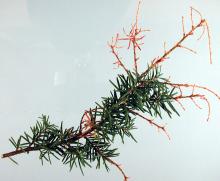See:
Cedar (Cedrus spp.) - Needle Blight
Cause Sirococcus tsugae, a fungus, has been found on western hemlock (Tsuga heterophylla) and on mountain hemlock (T. mertensiana). A similar disease occurs on atlas (Cedrus atlantica) and deodara (C. deodara) cedars. The fungus overwinters in dead shoots. Spores are rain-splashed from one tree to another. Infection is on or near the base of needles on new shoots as they begin to grow in the spring. On western hemlock the disease is especially apparent in natural stands on advanced regeneration in the understorey.
Symptoms On western hemlock the disease can affect one or many shoot tips on a single tree. On new shoots needles become chlorotic, shoots wilt and dieback resulting in a shepard's crook symptom. Trees take on a bushy appearance from repeated death of new shoots. In severe cases trees may die. On mountain hemlock the fungus also causes a shoot blight.
Cultural control
- Prune out affected branches if practical and remove plant debris that is found under trees or caught in limbs.
- Avoid overhead watering in summer.
- Keep seed lots separate when growing seedlings.
- Closely inspect new seedlings; remove any that show signs of infection.
Chemical control Start applications at bud break and continue at 2-week intervals when wet weather is expected.
- Armada 50 WDG at 3 to 9 oz/100 gal water. Do not use a silicone-based surfactant. Not for nursery or greenhouse use. Group 3 + 11 fungicide. 12-hr reentry.
- Bravo Weather Stik at 2 to 3.5 pints/A. Group M5 fungicide. 12-hr reentry.
- Echo 720 at 2 to 3.5 pints/A. Group M5 fungicide. 12-hr reentry.
- Heritage at 1 to 4 oz/100 gal water plus a non-silicone-based wetter sticker. Group 11 fungicide. 4-hr reentry.
- Mural at 4 to 7 oz/100 gal water. Group 7 + 11 fungicide. 12-hr reentry.
- Spectro 90 WDG at 1 to 2 lb/100 gal water. Group 1 + M5 fungicide. 12-hr reentry.
Reference Rossman, A.Y., Castlebury, L.A., Farr, D.F., and Stanosz, G. R. 2008. Sirococcus conigenus, Sirococcus piceicola sp. nov. and Sirococcus tsugae sp. nov. on conifers: anamorphic fungi in the Gnomoniaceae, Diaporthales. Forest Pathology 38:47-60.

